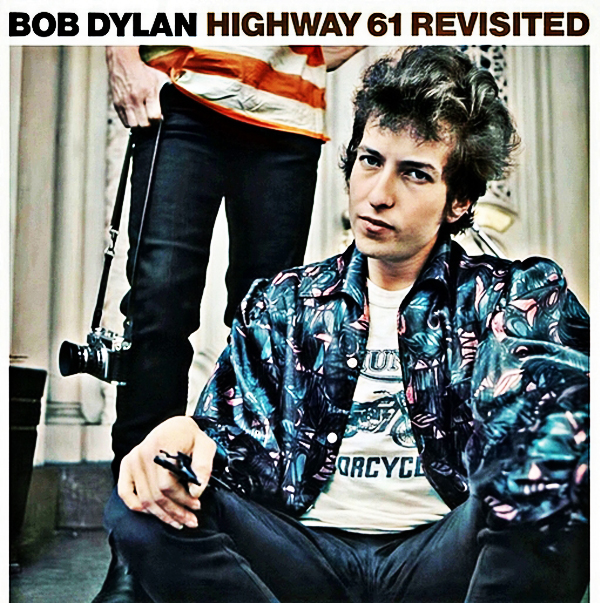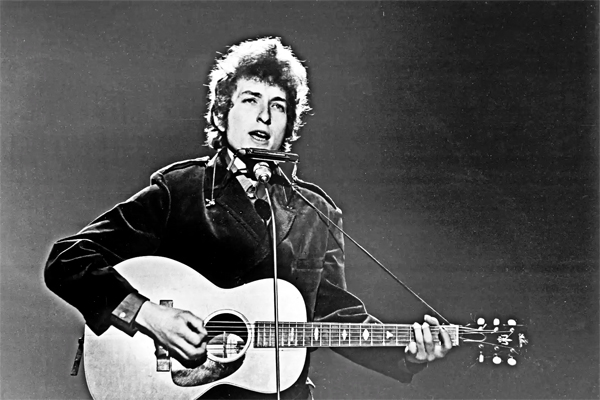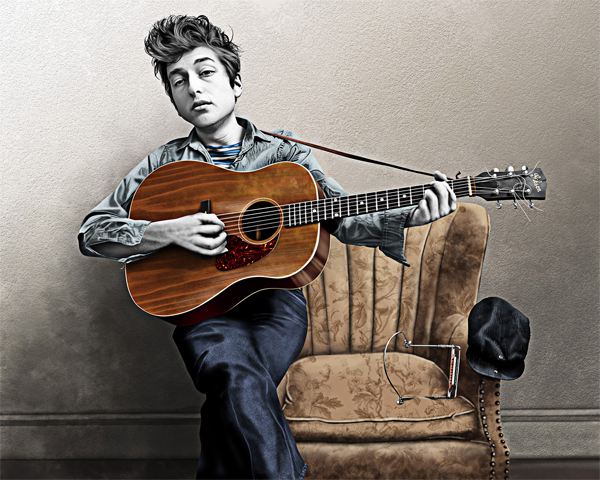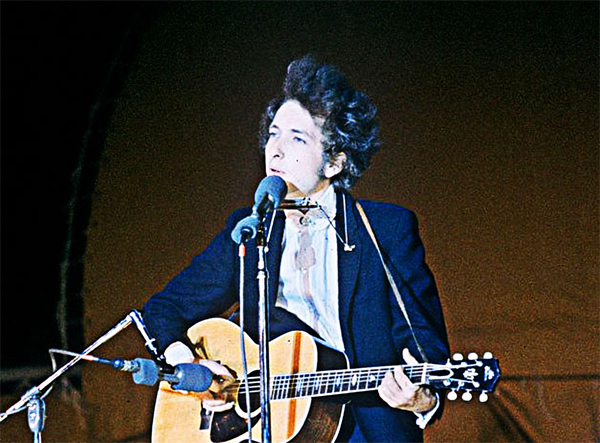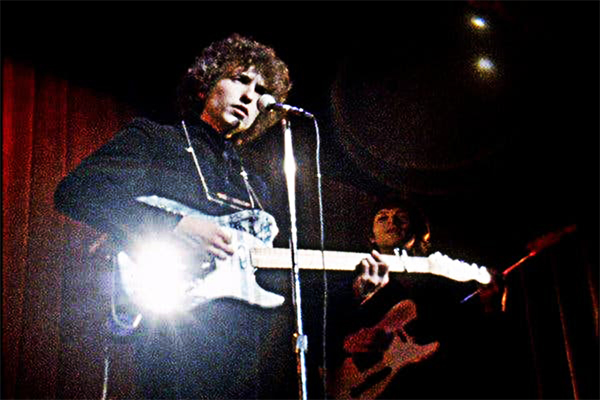SONG FACTS
“Like A Rolling Stone”  - Bob Dylan
- Bob Dylan
Album: Rumours
Released 1965 
An iconic Bob Dylan song,
“Like A Rolling Stone”  is the story of a debutante who becomes a loner when she falls out of high society.
It's a crushing blow, but there is an upside: when you got nothing, you got nothing to lose. Another advantage to being on your own: when you're invisible, you have no secrets to reveal.
is the story of a debutante who becomes a loner when she falls out of high society.
It's a crushing blow, but there is an upside: when you got nothing, you got nothing to lose. Another advantage to being on your own: when you're invisible, you have no secrets to reveal.
The title is not a reference to The Rolling Stones. It is taken from the proverb “a rolling stone gathers no moss”. Dylan got the idea from the 1949 Hank Williams song
“Lost Highway”  ,
which contains the line, “I'm a rolling stone, all alone and lost.”
,
which contains the line, “I'm a rolling stone, all alone and lost.”
Thanks to The Rolling Stones, many associate the phrase with a life of glamor, always on the move, but Williams' song is about a hobo paying the price for his life of sin. Dylan also used the phrase to indicate loneliness and despair: his rolling stone is “without a home, like a complete unknown”.
“Like A Rolling Stone”  is Dylan's most popular song and his first big hit, although having a hit song was low on his list of priorities.
is Dylan's most popular song and his first big hit, although having a hit song was low on his list of priorities.
It was the only single from his sixth album, Highway 61 Revisited, released in 1965 when he was buzzworthy - especially in the New York City music scene - but hardly a sensation. The song got significant airplay and many connected with it, sending them on an enlightening journey through his back catalog. Dylan became one of the most respected and analyzed songwriters of his time, with “Like A Rolling Stone” often the gateway.
Al Kooper, who was primarily a guitarist and went on to be a very successful music producer, played the famous Hammond organ riff on this song. If you listen very closely at the beginning, you'll notice the organ is 1/8th note behind everyone else. Kooper wasn't an expert on the organ, but Dylan loved what he played and made sure it was turned up in the mix.
When Songfacts asked Kooper what stands out as his finest musical accomplishment, he said:
“By the amount of emails I receive and the press that I get it is undoubtedly the organ part on ‘Like A Rolling Stone’. I kinda like the way Martin Scorsese edited my telling of that story in the documentary No Direction Home. For me, no one moment or event sticks out. I think reading my resumé every 10 years or so, is my finest moment - certainly my most incredulous. I cannot believe I did all the stuff I did in one lifetime. One is forced to believe in luck and God.”
The song runs 6:13, which was far longer than the typical pop song. Some radio stations wouldn't play songs that ran much more than three minutes, so it was a big breakthrough when
“Like A Rolling Stone”  got significant airplay. It was also rare for a song packed with so many lyrics to do well commercially.
got significant airplay. It was also rare for a song packed with so many lyrics to do well commercially.
Dylan's manager, Albert Grossman, who revolutionized the music manager profession and was known as a shrewd defender of his artists, was the one who told Columbia Records that they couldn't shorten the song to make it more radio friendly.
It took a few more years for another song this long to break through as a hit:
“Hey Jude”  by The Beatles in 1968.
by The Beatles in 1968.
Dylan based the lyrics on a short story he had written. What made it into the song is only a small part of what was in the story.
We have Dylan's producer, Tom Wilson, to thank for the organ on this song - he's the one who invited Al Kooper to the session. Wilson, who had been a jazz producer, started working with Dylan on his second album, The Freewheelin' Bob Dylan, released in 1963. He helmed Dylan's next three albums, but on Highway 61 Revisited only worked on “Like A Rolling Stone”, the last song he produced for Dylan. Bob Johnston took over as Dylan's producer and was behind the board for all the other tracks on the album.
It is rumored that this was written about one-time debutante Edie Sedgwick, who was part of artist Andy Warhol's crowd. She was the subject of an emotional tug-of-war between the Dylan camp and the Warhol camp.
According to this theory, the song includes some fanged, accusatory lines about Warhol and the way he mistreated the girl:
“Ain't it hard when you discover that
He really wasn't where it's at
After he took from you everything he could steal”
“Poor Little Rich Girl” Sedgwick is viewed by many as the tragic victim of a long succession of abusive figures. After escaping home and heading to New York, she ran into Warhol, who soon began to use her as his starlet. When her 15 minutes had come to an end, Warhol moved on.
Sedgwick and Dylan had a brief affair shortly before the musician married Sarah Lownds, and many say that this Dylan song was written about her. It should be noted that there is absolutely nothing beyond circumstantial evidence to support this idea, but the myth is so widely known that it's taken on a life of its own and is therefore recognizable on its own terms.
“Like A Rolling Stone”  made it to #2 in the U.S., held off the top spot by The Beatles'
“Help!”
made it to #2 in the U.S., held off the top spot by The Beatles'
“Help!”  Dylan had another #2 hit with
“Rainy Day Women #12 And #35”
Dylan had another #2 hit with
“Rainy Day Women #12 And #35”  ,
but never reached #1 as an artist. He did as a writer when The Byrds hit #1 with their cover of
“Mr. Tambourine Man”
,
but never reached #1 as an artist. He did as a writer when The Byrds hit #1 with their cover of
“Mr. Tambourine Man”  in 1965.
in 1965.
This song made Bob Dylan an unlikely inspiration for Jimi Hendrix version of
“Like A Rolling Stone”  ,
who before hearing it considered himself a guitarist but not a singer.
Dylan proved you didn'ta conventional voice to sing rock and roll.
,
who before hearing it considered himself a guitarist but not a singer.
Dylan proved you didn'ta conventional voice to sing rock and roll.
Hendrix often played
“Like A Rolling Stone”  ,
including a performance at the 1967 Monterey Pop Festival.
Hendrix and Dylan met only once, but Jimi had a knack for bringing out the emotions in Dylan's songs: he also did a very successful cover of
“All Along The Watchtower”
,
including a performance at the 1967 Monterey Pop Festival.
Hendrix and Dylan met only once, but Jimi had a knack for bringing out the emotions in Dylan's songs: he also did a very successful cover of
“All Along The Watchtower”  .
.
Dylan recorded another version in 1970 for his Self Portrait album. This time, he used experienced session players in Nashville, Tennessee. Ron Cornelius played guitar on the album and told Songfacts about the session:
“You're not reading manuscripts. In Nashville the players are booked because of what they can create right now, not what's written on a piece of paper. Everybody's creating their part as the tape is rolling. Out of everybody I've worked with, I don't know of anyone who's been any nicer than Bob Dylan. He treated me wonderfully, but at the same time you knew being around him day after day that this man wakes up in a different world every morning. On a creative level that's a really good thing and to try to second guess him or to ask him what he actually meant by these lyrics, you're shooting in the dark because he's not going to tell you anyway. And he might be telling you the truth when he says ‘I don't know, what does it mean to you?’”
The Rolling Stones didn't take their name from this song, but rather the 1950 Muddy Waters track
“Rollin' Stone”  .
The magazine Rolling Stone was named after this song, with a degree of separation:
.
The magazine Rolling Stone was named after this song, with a degree of separation:
Ralph Gleason wrote a piece for The American Scholar about the influence of music on young people called “Like a Rolling Stone”, which he titled after the song. When he founded the magazine with Jann Wenner in 1967, they decided to name it after his story. Wenner muddied the waters a bit when he wrote in the debut issue:
“Muddy Waters used the name for a song he wrote. The Rolling Stones took their name from Muddy's song. “Like a Rolling Stone’ was the title of Bob Dylan's first rock and roll record.”
Dylan's original draft of the song's lyrics were written on four sheets of headed note paper from the Roger Smith Hotel in Washington, DC.
The quartet of handwritten pages fetched over $2 million at Sothebys New York in June 2014, setting a new price record for a popular music manuscript.
he previous record was John Lennon's handwritten lyrics for the 1967 Beatles track
“A Day In The Life”  ,
which cost $1.2 million.
,
which cost $1.2 million.
An early manuscript of this song in the Dylan archives at the Center for American Research in Tulsa reveals some lyrics that were later changed or removed. Instead of “You used to laugh about”, it was ”You used to make fun about.” Some lines that were excised:
“You've studied all these great theories on life”
“And now you find out they don't mean a thing”
“You've been blessed by counts these old friends claimed to love”
“Now they're all ashamed of you.”
